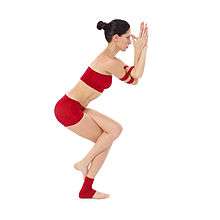Garudasana

Garudasana (gah-roo-DAH-sah-nah[1]; Sanskrit: गरुडासन; IAST: Garuḍāsana) or Eagle Pose[2] is an asana.
Etymology
The name comes from the Sanskrit words garuda meaning "eagle", and asana meaning "posture" or "seat".[3]
In Hindu mythology Garuda is known as the king of birds. He transports the God Vishnu[4] and is eager to help humanity fight against demons. The word is usually rendered into English as "eagle," though according to one dictionary the name literally means "devourer," because Garuda was originally identified with the "all-consuming fire of the sun's rays".[5]
Description
This standing asana may enhance concentration.[6] It focuses on the ankles, calves, thighs, hips and shoulders.
Variations
Usually Garudasana is performed with a straight spine, so that it shows the mythical bird Garuda. But most of people make their spine round, which could be interpreted as a mistake or a variation.
Gallery
See also
References
- ↑ Budilovsky, Joan; Adamson, Eve (2000). The complete idiot's guide to yoga (2 ed.). Penguin. p. 153. ISBN 978-0-02-863970-3. Retrieved 11 April 2011.
- ↑ "Yoga Journal - Eagle Pose". Retrieved 2011-04-09.
- ↑ Sinha, S.C. (1 June 1996). Dictionary of Philosophy. Anmol Publications PVT. LTD. p. 18. ISBN 978-81-7041-293-9. Retrieved 9 April 2011.
- ↑ "Vishnu Garudasana". Musée Guimet. Retrieved 2011-06-25.
This extremely well preserved work represents the god Vishnu astride his traditional mount, Garuda.
- ↑ Jordan, Michael (August 2004). Dictionary of gods and goddesses. Infobase Publishing. pp. 102–. ISBN 978-0-8160-5923-2. Retrieved 25 June 2011.
- ↑ VanEs, Howard Allan (12 November 2002). Beginning Yoga: A Practice Manual. Letsdoyoga.com. pp. 66–. ISBN 978-0-9722094-0-3. Retrieved 25 June 2011.
Builds balance, coordination, and concentration.
Further reading
- Iyengar, B. K. S. (1 October 2005). Illustrated Light On Yoga. HarperCollins. ISBN 978-81-7223-606-9. Retrieved 9 April 2011.
- Saraswati, Swami Satyananda (1 August 2003). Asana Pranayama Mudra Bandha. Nesma Books India. ISBN 978-81-86336-14-4. Retrieved 9 April 2011.
- Saraswati, Swami Satyananda (January 2004). A Systematic Course in the Ancient Tantric Techniques of Yoga and Kriya. Nesma Books India. ISBN 978-81-85787-08-4. Retrieved 9 April 2011.